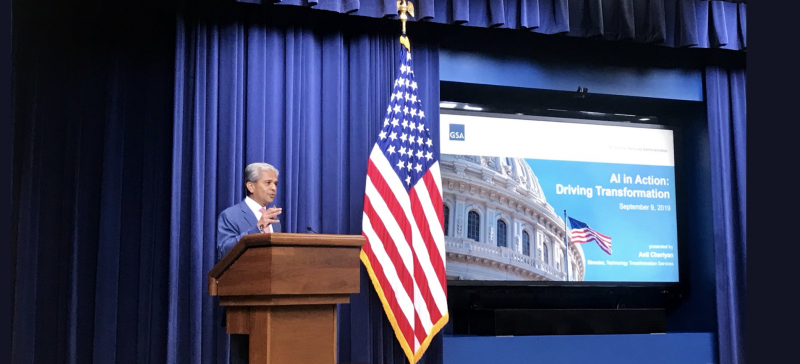The Trump administration’s plan to develop artificial intelligence (AI) expertise across the federal workforce includes launching a cross-governmental community of practice around AI in early October. The hope is that community will feed into a larger initiative, aimed at embedding AI professionals within agencies to help improve government services to the public.
This larger initiative, known as Centers of Excellence (CoE), is still fairly new but has already shown promising results at the Agriculture Department, for example. Under the CoE model, centralized teams of technical experts work alongside agency employees to accelerate the adoption of modern technologies, such as cloud computing and data analytics.
AI is next on that list.
“That is all about accelerating and driving and scaling the execution of AI across the government,” said Anil Cheriyan, Director of the General Services Administration’s (GSA) Technology Transformation Services (TTS) office. Speaking during the Sept. 9 White House Summit on Artificial Intelligence, Cheriyan explained how the Centers of Excellence (CoE) initiative, which is housed within TTS, will be used to drive government adoption of AI.
Cheriyan noted that to properly tap into the existing AI groundswell across government, TTS is first connecting those who are interested in and actively using AI. That’s where the community of practice comes in. Next steps there include hiring an AI lead to coordinate among government’s AI users and then launching the community of practice by early October.
The expectation is that knowledge derived from the community of practice will help agencies that want to adopt AI more holistically. Practically speaking, experts from that community could lend their expertise and potentially embed at an agency to work alongside their employees on AI projects.
The Agriculture (USDA) and Housing and Urban Development (HUD) departments are already using the CoE approach to tackle pressing issues that affect the public. For example, the CoE team at USDA developed a digital tool to streamline the farm loan process for new producers. The Office of Personnel Management (OPM) and more recently the Consumer Product Safety Commission (CPSC) are also following suit to improve the customer experience.
As the latest agency to adopt the CoE model, CPSC kicked off the discovery phase to assess the current state of operations there and what improvements and technology, such as AI or analytics, are best to address any issues. CPSC is an independent agency charged with reducing the risk of injuries and deaths from consumer products.
“We believe that coming out of the discovery phase [at CPSC] they will need some AI and machine learning to help with the analysis of consumer complaints,” Cheriyan told GovLoop.
The Centers of Excellence team is also in active discussions with the Joint Artificial Intelligence Center (JAIC) to establish a formal agreement for accelerating and expanding AI adoption within the Defense Department. JAIC was created in June 2018 to accelerate the delivery of DoD’s AI-enabled capabilities, scale AI’s impact departmentwide and synchronize the technology’s activities to expand Joint Force advantages.
The JAIC has a physical home in an office space in Arlington, Virginia and is now up to 112 employees, including contractors. That’s up from a half a dozen people and little money just a year ago, Lt. Gen. John N.T. “Jack” Shanahan, Director of DoD’s Joint Artificial Intelligence Center, said during the summit.
By prioritizing this partnership with the Centers of Excellence, Shanahan said this will help ensure that AI projects are accelerated and not floundering in the research and development stage with little progress.
Cheriyan cited several other use cases for AI in government, including powering job application processing and supplementing workforce shortages. He also highlighted the ability for AI to drive predictive-type work, such as loan underwriting at HUD and fraud prevention at the IRS. There are also opportunities to couple AI with robotic process automation (RPA) systems to help drive underlying decision-making.
The speaker lineup of heavy hitters during the White House summit, which included Advisor to the President Ivanka Trump, was reflective that AI adoption in government must span beyond chief information officers and other technologists to be successful. “Artificial intelligence as you all know is really embryonic in terms of its opportunity, but we think it’s incredibly important, Chris Liddell, White House Deputy Chief of Staff for Policy and Coordination, said during the start of the summit. “So today is [an] important first step.”
The White House summit focused on the importance of the U.S. leading in industries of the future, such as AI, 5G and quantum and, more specifically, how government adoption of AI to advances agencies’ missions and enables them to better serve the public.
Photo Credit: General Services Administration





This is great news! I’m excited to see replication of the CoE model for AI given the successes we’ve already seen, and I’m glad that federal leadership all the way up to the White House is on board!